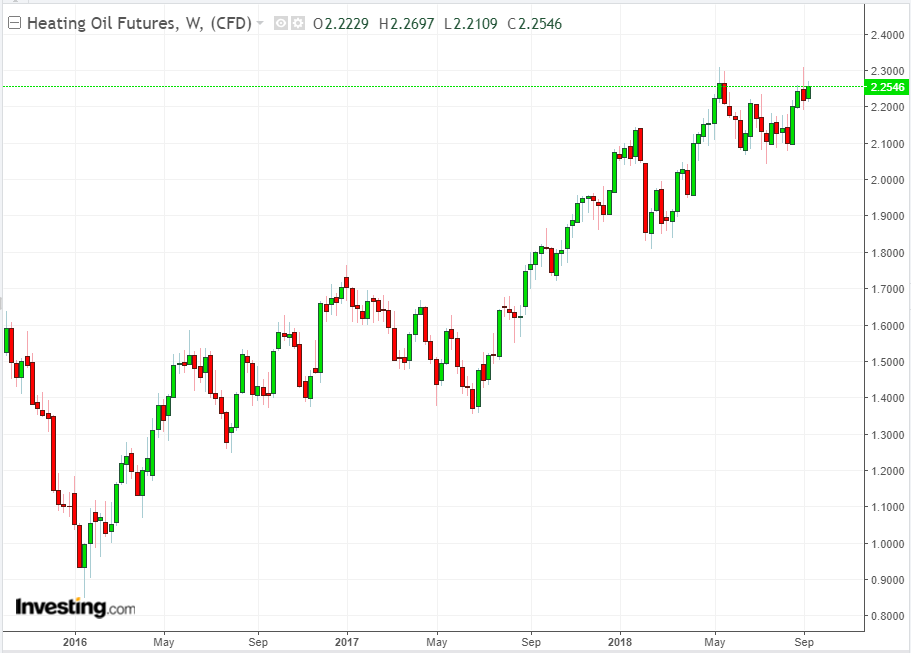Unlike other US energy commodities, diesel is the one energy market that's currently trading close to its 3-1/2 year highs, and will likely continue climbing. We’re not talking about West Texas Intermediate (WTI) crude or gasoline but actually about heating oil.

Also known as ultra low sulfur diesel (ULSD), this is a market where traders expect to see crackling demand over the next two quarters from winter heating needs as well as for trucking goods for the holiday season. New York-traded HO’s most-active October contract settled on Wednesday at $2.2577 per gallon, up 27 percent from a year ago. On September 4, the contract soared to $2.3093, a high since February 2015.
The average US weekly retail rate for diesel was $3.258 per gallon and peaked at $3.969 in California, its priciest location. The US Energy Information (EIA), in its latest Short-Term Energy Outlook, pegged the 2018 average for diesel at $3.17 and for 2019 at $3.18.
Strong Buy With No Meaningful Sell Targets
Investing.com's daily technical outlook has placed a "Strong Buy" on HO, with no meaningful sell targets in the near future. Traders interviewed for this story agree, saying it’s hard to set any independent price target for the fuel given the seasonal factors for its demand and its base pricing, which is still determined by crude oil.
“Diesel fuel’s fundamentals are a lot better than gasoline as there’s a deficit of supply, opposed to the surplus in gasoline,” said Jim Ritterbusch of the Chicago-based Ritterbusch & Associates energy markets consultancy. EIA’s latest weekly figures on petroleum stockpiles put gasoline inventories at 235.9 million barrels versus 139.3 million for distillates, which represent both HO and ULSD.
“I’m going to stay that ULSD is going to be well supported for another four to five weeks at least from seasonal demand, without venturing an upside or downside,” Ritterbusch added.
Phil Davis, a trader at PSW Investments in New York, was just as non-committal on making a price guess.
“It’s kind of hard to make a call on this market because it’s an optional thing that refineries make and they only make as much as they think demand is going to be. So, it’s really a kind of a hit-and-miss thing during winter … a hit if refiners correctly estimate the heating demand then. And if you take away the diesel equation, it’ll just be following the ups and downs in crude oil prices because that’s really the basis for HO.”
Originally intended only for producers, sellers and buyers of heating oil, the HO market has taken on grander significance since May 2013 after ULSD became part of its mix. Under redefined specifications, the commodity began carrying less than 15 parts per million (ppm) of sulfur, the same used in most diesel fuel. That automatically made it a hedging tool for traders of automotive diesel.
Fuel For Heating Now More Symbolic Than Actual
While it remains one of the core US fuels for providing warmth during winter, particularly in the country’s northeast, demand for HO has largely been replaced by natural gas over the past 30 years amid the United States’ move toward green fuels. According to the EIA, about 5.7 million households in the United States—from a total of 126.2 million, or 5 percent—still use heating oil.
The demand concentration for HO is largely in the northeast, where it is used in about 20 percent of households. Leaving aside the symbolism of HO for heating, what’s really driving prices of the fuel now is the ULSD, or diesel factor, say some analysts.
The contracts for December, which would cover the Christmas and New Year holidays, and for February 2019, which coincides with the peak of winter needs, hover at just over $2.27 per gallon now. That’s a premium of just 1 cent from the current October benchmark and does not justify the demand reality for ULSD, particularly on the exports front, say analysts who track shipment data for the fuel.
US Diesel Exports Holding Up Strongly
“Exports of ULSD are holding up pretty strongly and current US refinery runs of over 97 percent for all fuels have wrong-footed peoples’ expectations,” said Matt Smith of New York-headquartered oil cargo surveyor Clipperdata.
Up until April, US east coast exports of middle distillates such as jet fuel and diesel were at more than 100,000 barrels per day, up from an average of 18,000 bpd in the first quarter, Smith said. About half of those exports are headed to Brazil. He added:
“The supply squeeze you have on crude now from the US restrictions on Iranian oil, the economic meltdown in Venezuela and the storm threats in the Atlantic are combining into a sizeable premium for energies as a whole, and ULSD is benefiting from that too.”
Demand for US diesel from Brazil and Canada, coincided with a spike in heating oil usage during the extremely cold 2017/18 winter. This led to a price surge in ULSD last year. And while WTI hit five-month lows in May 2017, ULSD rallied from strong international demand, prompting importers to tell US refiners to just turn the crude into diesel.
A Bloomberg story from September of last year also said then that it was diesel that was driving up crude prices, not the OPEC cartel, which is famous for its market manipulation.
